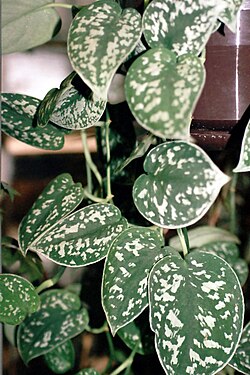| Scindapsus | |
|---|---|
 | |
| Scindapsus pictus var. argyreus | |
| Scientific classification | |
| Kingdom: | Plantae |
| Clade: | Tracheophytes |
| Clade: | Angiosperms |
| Clade: | Monocots |
| Order: | Alismatales |
| Family: | Araceae |
| Subfamily: | Monsteroideae |
| Tribe: | Monstereae |
| Genus: | Scindapsus Schott |
| Synonyms [1] | |
CuscuariaSchott | |
Scindapsus is a genus of flowering plants in the family Araceae. It is native to Southeast Asia, New Guinea, Queensland, and a few western Pacific islands. [1] [2] [3] The species Scindapsus pictus is common in cultivation.
Contents
Scindapsus is not easily distinguishable from Epipremnum . The main difference between the two genera is in the number of seeds they produce. Scindapsus species have one ovule in each ovary whereas Epipremnum species have a few. The seeds of Scindapsus are rounded to slightly kidney-shaped. The plants are primarily root climbing vines. [4]